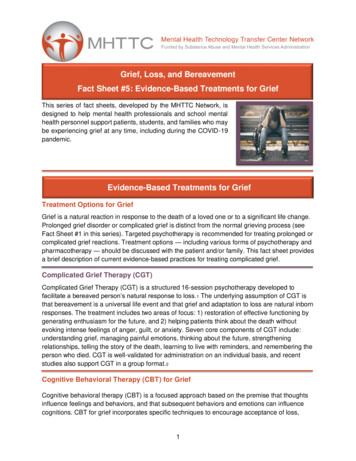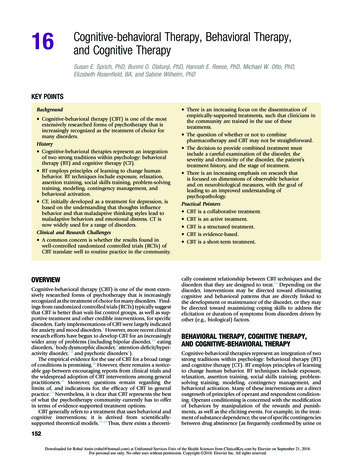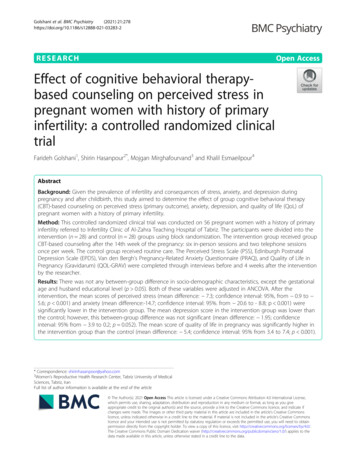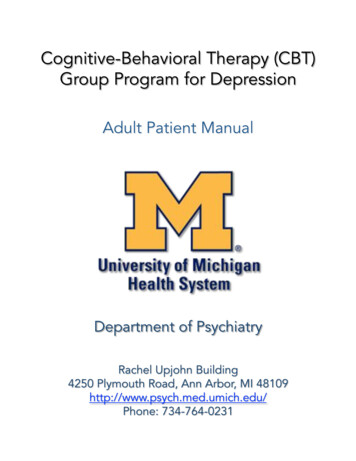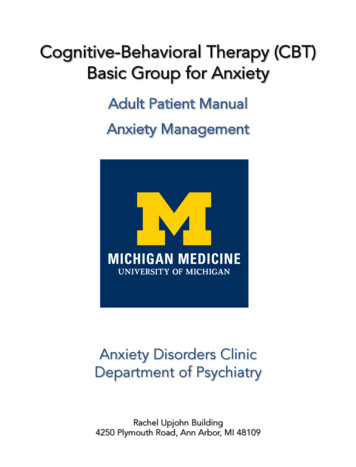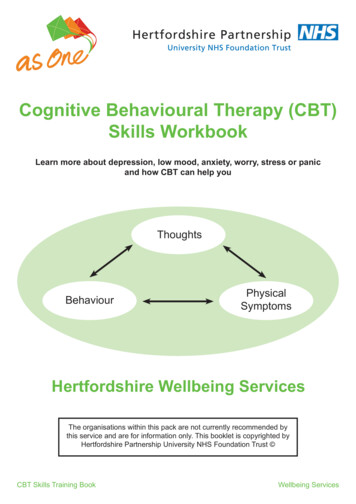
Transcription
Cognitive Behavioral Therapy (CBT)for TinnitusCaroline J. Schmidt, PhDNCRAR Biennial ConferenceOctober 6, 2017
Keeping Things Legal The opinions expressed do not necessarilyreflect the position or policy of theDepartment of Veterans Affairs or theUnited States Consultation for VA CRADA: Desyncra
Acknowledgements James Henry, PhDRobert Kerns, PhDTara Zaugg, AuDPaula Myers, PhD, CCC-AChristine Kaelin, MBAEmily Thielman, MSSarah Theodoroff, PhDCatherine Edmonds, AuDCherri Ribbe, AuDJohnna Gonzalez, MS, BSN Kathryn LaChappelle, MSSamantha Boris Karpel, PhDCyndi Trueheart, AuDSuzanne Finkel, AuDElias Michaelides, MDGaby Saunders, PhDRuth Leibowitz, PhDMarie-Christine Goodworth,PhD Stephen Boyd, PhD David Cornwall, RN
Learner Outcome #1Participants will be able to describe therationale for basic components of cognitivebehavioral therapy.
Learner Outcome #2Participants will be able to describe theclinical evidence supporting CBT and PTM
Learner Outcome #3Participants will be able to describe twodelivery models for offering CBT within PTM.
Topics1.Literature Review2.Implementation of CBT-TA. Session contentsB. Future directions
1. Literature Review
Reviews of CBT-T Systematic reviews Cochrane Reviews Clinical practice guidelines (CPGs)
CBT for Tinnitus StudiesAuthorsYearNumber of SessionsCountryCima, Maes, Joore, Scheyen, El Refaie,Baguley, Anteunis, Breukelen, Vlaeyen2012Up to 12 sessionsNetherlandsGraul, Klinger, Greimel, Rustenbach,Nutzinger2008Variable (inpatient);Averagelength of stay 56.12 days (SD Germany8.55)Kaldo, Levin, Widarsson, 0 (review)SwedenRobinson, Viirree, Bailey, Kindermann,Minassian, GoldinSadler, Stephens, KennedyAndersson, Porsaeus, Wiklund, Kaldo,LarsenHiller, HaerkotterAndersson, KaldoZachriat, Kroner-HerwigKroner-Herwig, Frenzel, Fritsche,Schilkowsky, EsserAnderssonAndersson, Strömgren, Ström, Lyttkens2002Wise, Rief, GoebelHenry (JL), Wilson19981996Davies, McKenna, Hallam1995Kroner-Herwig, Hebing, Van RijnKalkmann, Frenzel, Schilkowsky, EsserJakes, Hallam, McKenna, Hinchcliffe6Sweden1066 (2 additional sessions asneeded)GermanyAustralia199510Germany19925UKUK
CBT for tinnitus vs. WLCEffect Sizes1. Cima, et al (2012); N 336; THId 0.32 (3 months)d 0.52 (8 months)2. Andersson, et al (2005); N 23; TRQd 0.34 (post-tx)
Cochrane Reviews Relating toTinnitus Management CBT: Overall strongest body of evidencesupporting its effectiveness for tinnitus. Sound therapy: Studies have not shownthat sound therapy on its own providessignificant benefit. Hearing aids for tinnitus: No new reviewsbut there is recent evidence of significantbenefit for tinnitus.
Recommendations for Clinical Practicefor Patients with TinnitusAmerican Academy of Otolaryngology – Head & Neck Surgery Foundation (AAO-HNSF)1.2.3.4.5.6.History and physical exam (ENT)Audiologic exam (some patients)Distinguish acute v chronic & bothersomeEducate about treatment optionsHearing aid evaluationCognitive-behavioral therapy (CBT)
AAO-HNSFOther care options1. Audiologic exam (all patients)2. Sound therapy
Possible Components: CBT-T PsychoeducationStress managementBehavioral activationCognitive restructuringExposure (internal/external sound)Sleep managementControlling distractibility
VA Studies of PTM CBT for Tinnitus (pilot study)Tele-PTM (pilot study)Multi-site Evaluation of PTM (RCT)Tele-PTM (RCT)
CBT for tinnitus (pilot) Research question: How can we cater tinnitusinterventions to best serve Veterans distressedby tinnitus? Design: Single-blind, randomized, paralleltreatment concurrent design Inclusion/Exclusion: Tinnitus “primary” healthconcern; minimal distress levels; no vestibularcomplaints; no SI Intervention: CBT by psychologist vs. Counselingby audiologistFunded by: VA RR&D CDA-1 (C. Schmidt) and VA RR&D pilot Merit (R. Kerns)
Veterans are Unique1) Increased probability of low healthliteracy and socioeconomic status2) Increased likelihood of a history ofacoustic and/or psychological trauma3) Overrepresentation of males4) Increased probability of having a mentalhealth disorder5) Highly diverse
Components: CBT-T in Pilot PsychoeducationStress managementBehavioral activationCognitive restructuringExposure (external sound)Sleep management
Participant Flow
THI
TRQ
Specific Modifications to CBT-T forVeterans1. More clearly describe the rationale forcomponents2. Use steps for behavioral activation(pleasant activities)3. Integrate services with Audiology
Overview of CBT within PTM
Five Hierarchical Levels of PTM
Level 3 Skills Education Workshops or one-on-one for patientswho require tinnitus-specific intervention
Level 4 Interdisciplinary Evaluation In-depth tinnitus evaluation byaudiologist and psychologist
Level 5 Individualized Support One-on-one support from audiologistand/or psychologist
PTM Books1. Progressive Tinnitus Management:Clinical Guide for Audiologists2. How to Manage Your Tinnitus: A Step-byStep Workbook3. Progressive Tinnitus Management:Counseling Guide
First Question: Does thePerson Have Tinnitus? Differentiation from auditory hallucinations Musical tinnitus AH without psychotic disorder Overlap among symptoms and disorders Erring on the side of empathy and caring Veterans versus non-military personnel
What if the PatientNeeds Hearing Aids? Fit combination instruments (hearing aidswith embedded sound generators) Suggest leave sound turned off at first todetermine potential effects of amplificationon tinnitus Reassess with patient preferences
Reach Out to Primary Care Audiologist or MH provider roleInform of tinnitus services: how we helpProvide handouts for patientsDiscuss preferred communication b/tproviders and with patients How to discuss tinnitus with patients Be prepared with research evidence Discuss specific patients
Entry Points for ReceivingPTM at VA Connecticut1. Audiologist formal consult (Level 2) drop in to Audiology clinic (Level 2) education groups (Level 3)2. Psychologist formal consult (Level 2 or Level 3) education groups (Level 3)
What is Health Psychology? Specializes in bio-psycho-social modelExplores these effects on physical healthPromotion and maintenance of healthPrevention, treatment and rehabilitation ofillness and disability Improvement of the health care system
The Role of MH Providersin Tinnitus Management Education with patients: etiology,interventions, comorbid conditions andsymptoms Consultation: candidacy for group/ind,priority of care, crisis, MH symptoms,shared decisions, communicationstrategies with patients Reinforcement: skills, rationale, goals
How to Discuss MH withPatients Emphasize the program: Evidence basedExplain what a Health Psychologist doesShow you want provide optimal careReaffirm their experience and inform:– We believe your tinnitus is real.– Psychologists can help people cope with a varietyof chronic health problems such as pain,insomnia, and tinnitus.– This does not mean you have a MH disorder(even though you might have one).
Getting MH Involved Look in record or ask patient if they alreadysee MH (in VA MHTC or notes) Meet with leadership (CHP or Chief) Inform them of existing protocol and researchevidence for CBT-T Clarify the role: consultation, collaboration,transfer of care (depending on your need) Use MH to assist with challenging patients Offer an in-service
Information to Provide MH PTM Workbook and Jim and my contacts Describe what help you need at any givenmoment (consultation, intervention, group,assessment, etc.) Develop a plan for referrals (consultationrequests, drop-in groups, additional signeron notes, scheduling directly into clinics)
Tele-PTM (Pilot Study)
Results All 3 groups showed similar improvementin mean THI scores demonstratingmoderate to large effects. Participants in the mTBI and m-sTBIgroups reported greater prevalence ofsleep disturbance and anxiety withprobable PTSD. Suicidal ideation is very challenging toaddress from a distance by telephone.
Multi-site Evaluation of PTM (RCT)
Summary of Findings PTM is significantly more effective thanWLC for decreasing tinnitus distress asmeasured by the THI and TFI andimproving self-efficacy. Methods to increase attendance is needed(only 36% attended all 5 sessions; 61%either attended all 5 sessions or reportedviewing the videos).
Results – Attendance (ImmediateCare)
Tele-PTM (RCT)(in review)
CBT-T: Session #1– Group support basics– Addressing stigma– Problem solving– Rationale for program/CBT cycle– Stress management (relaxation)– Behavioral activation (pleasant activities)
CBT-T: Session 1
ABC Model of CBT-T
Stress Management:Rationale Reducing stress can help you cope w/tinnitus and other health problems. Many people with tinnitus report it seems(more distressing, louder, morebothersome) when they are under stress. Sleep disturbance is often a concernamong people with tinnitus; relaxationexercises can promote sleep.[Note: be prepared with sound!]
(Diaphragmatic) Deep BreathingRationale The most basic relaxation exercise. Deep breathing is helpful for other morerelaxation exercises. It promotes circulation and respiration. It can be practiced in many situations (car,work, bed)
(Guided) ImageryRationale Imagery is imagining you are some placecalming, peaceful and safe More cognitively challenging Promotes more positive emotions Sensory focused
CBT-T: Session #2– Review of previous sessions– Addressing barriers– Defining thought errors– Observing thoughts/emotions
Planning Pleasant ActivitiesRationale When people are distracted, they don’tnotice their tinnitus as much. Pleasant activities can improve mood. Behavioral activation is a primarycomponent of CBT for depression. There’s no right or wrong way to planmore pleasant activities.
Steps for PlanningPleasant Activities Step 1: Observe current activity level Step 2: Brainstorm activities Step 3: Plan pleasant activities
Cognitive Restructuring Called “Changing Thoughts and Feelings”in PTM Step 1: Being mindful of thoughts “Catch it, check it, change it” http://downloads.bbc.co.uk/headroom/cbt/catch it.pdf The least utilized skill, but it has potentiallyprofound effects.
8 Automatic Thoughts(Thought Errors)1.Mental FilterDefinition: When you pay the most attention to bad eventsor traits even though they are only a part of the picture. Youmight also not notice positive events or traits.General example: “I don’t like my nose, and that means Iam ugly.”Tinnitus example: “My tinnitus is unpleasant, and thatmeans I can’t have fun anymore.”Positive thought example: “My tinnitus is unpleasant, butwhen I do fun things I notice it less.”
8 Automatic Thoughts(Thought Errors)2.Mind ReadingDefinition: When you believe you know what others are thinkingwithout them telling you.General example: You see some younger people watching youget into your car and hear one of them laugh. You tell yourself,“They think because I’m old I should stop driving.”Tinnitus example: You share with a friend how your sleep isaffected by your tinnitus. Your friend suggests you might behappier if you focused on the positive things happening in yourlife. You tell yourself, “That person thinks my tinnitus should notmatter to me and only likes me when I talk about happy things.”Positive thought example: “My friend really cares about me evenif her advice isn’t helpful.”
8 Automatic Thoughts(Thought Errors)3.Fortune-TellingDefinition: When you predict the future, usually assumingsomething bad will happen. When the future is uncertain,may automatically think about the worst case scenario.General example: “If I go to the party, I won’t have fun.”Tinnitus example: “My tinnitus is going to get worse andworse until I won’t be able to handle it.”Positive thought example: “There’s no telling if my tinnituswill get worse. If it does, I have strategies to deal with it.”
8 Automatic Thoughts (Thought Errors)4.“Should” StatementsDefinition: When you have a fixed idea about how people orsituations should or must be. When people (including you) andsituations don’t meet those expectations, you judge them veryharshly. “Should” statements often go hand and hand withfeelings of anger, impatience, guilt, and disappointment, andsimilar words such as “would,” “could,” and “ought.”General example: “People should always drive the speed limit.”Tinnitus example: “I should just suck it up and deal with mytinnitus (and if I’m not sucking it up there is clearly somethingwrong with me).”Positive thought example: “Sometimes my tinnitus is annoyingeven when I use my coping skills. I’m doing my best. Some daysare going to better than others.”
8 Automatic Thoughts(Thought Errors)5.Labeling:Definition: When you attach a negative word to yourself oranother person as a general statement.General example: You don’t complete a task and tellyourself, “I am just a lazy person.”Tinnitus example: You feel sad sometimes about yourtinnitus, and you tell yourself, “I am not strong enough tohandle this. I am weak and childish.”Positive thought example: “It’s okay that I’m sometimes sadabout having tinnitus.”
8 Automatic Thoughts(Thought Errors)6.Making things personalDefinition: When you think that things that happen arebecause of you, even though there could be many othercauses.General example: “That person didn’t say hello to mebecause he doesn’t like me.”Tinnitus example: “I must have done something wrong todeserve my tinnitus.”Positive thought example: “I’m a good person who happensto have a health problem.”
8 Automatic Thoughts(Thought Errors)7.All or Nothing ThinkingDefinition – You see things as good or bad with nothing inbetween. Using words like “always,” “never,” “no one,”“everyone,” and “all” are often clues that you are thinking inthis way.General Example: “You never come through for me.” (Ifthis is said to a friend who sometimes is helpful andsometimes is not.)Tinnitus example: “Either I find a cure for my tinnitus or Iremain miserable.”Positive thought example: “Even if I always have tinnitus, itdoesn’t have to be the center of my life.”
8 Automatic Thoughts(Thought Errors)8.Emotional ReasoningDefinition: You use your emotions as “proof” that something istrue, even if there is no clear evidence to support the belief.General example: Because you feel anxious about meeting newpeople, you tell yourself that it’s better not to meet new peoplebecause they will only reject you.Tinnitus example: Because you are nervous about seeking helpfor your tinnitus, you tell yourself that no one can help youanyway.Positive thought example: “Even though I am nervous aboutasking for help, I can still pick up the phone.”
CBT-T: Session #3– Review of previous sessions– Addressing barriers– Discussing observations about thoughts– Changing thoughts– Relapse prevention (next steps)
Changing ThoughtsStep-by-StepEXAMPLE:Step 1: Identify the event that led to this thought:My coworker said his tinnitus is no big deal.Step 2: Fill in a negative thought about tinnitus from lastweek: No one believes how loud my tinnitus is – noteven other people with tinnitus.Step 3: Write down your feelings when you have thisnegative thought: Lonely, frustrated, and angry
Changing ThoughtsStep-by-StepEXAMPLE (continues)Step 4: What is true about the thought in Step 2? Whatmakes sense or is evidence for that thought? No one elsehas said they have experienced their tinnitus like I do.Step 5: What is not true about the thought in Step 2? Whatdoes not make sense about that thought? Maybe theyaren’t saying what they believe; I haven’t met a lot ofpeople who have tinnitus.Step 6: Write a new, more helpful thought: I can’t readminds. It doesn’t matter what other people believe.
Changing ThoughtsStep-by-StepEXAMPLE (continues)Step 7: Write down feelings you have when you thinkabout this new thought? A little sad; and less frustrated.[Pause to consider this: Are your feelings in Step 7 morepositive than your feelings in Step 3? If no, go to Step 6and revise your new thought. If yes, go to Step 8.]Step 8: Think about the event happening in Step 1. Nextimagine having the new thought in Step 6.
Delivery Models Integrated: providers are co-located andshare intervention responsibilities Stepped care: patients see one disciplineat a time as needed Progressive: patients receive only the carethey need Interdisciplinary: disciplines shareframework Multidisciplinary: disciplines alternate(silos)
Provider Overlap VariesAudiologistOtherdisciplinesPsychologist
When should audiologistsprovide CBT? Following supervised experience Share your level of expertise with patientsBarriers:– Local licensing laws– Reimbursement issues
Should psychologistsprovide sound therapy? Shared limitations with patients Must receive proper training andknowledge Consultation with audiologist Supportive role to audiologist
Overall Future Directions Implementation challenges– Provider shortage– Integration of services– Tele-health Alternatives to CBT-T in PTM– Exposure therapy– Acceptance and Commitment Therapy (ACT)– Integrative medicine: mindfulness-based stressreduction, acupuncture, self-guided– Prioritizing goals and components
References1.Boudin, A., Carlson, K. C., Elnitsky, C., Esquivel, C., Camou, E., Thielman, E., Henry, J. A. “Online Surveys of Tinnitus Management Practices inVA and DoD: Results and Clinical Implications.” Joint Defense Veterans Audiology Conference (JDVAC), St Louis, MO, 2016.2.Carlson, K. C., Thielman, E., Zaugg, T. L., Elnitsky, C., Tuepker, A., Kaelin, C., Henry, J. A. “VA Clinician Surveys and Interviews Reveal Need forIncreased Mental Health Involvement in Tinnitus Management.” Joint Defense Veterans Audiology Conference (JDVAC), St Louis, MO, 2016.3.Henry, J. A., Griest, S., Thielman, E., McMillan, G., Kaelin, C., Carlson, K. The Tinnitus Functional Index: Development, validation, outcomesresearch, and clinical application. Hearing Research 334:58-64, 2016.4.Henry, J. A., Thielman, E. J., Zaugg, T. L., Kaelin, C., Schmidt, C. J., Griest, S., McMillan, G. P., Myers, P., Rivera, I., Baldwin, R., Carlson, K.Randomized controlled trial in clinical settings to evaluate effectiveness of coping skills education used with Progressive Tinnitus Management.Journal of Speech Language and Hearing Research. (in press)5.Henry, J. A., Zaugg, T. L., Myers, P. J., Kendall, C. J. Progressive Tinnitus Management: Clinical Handbook for Audiologists. San Diego, CA:Plural Publishing Inc., 2010.6.Henry, J. A., Zaugg, T. L., Myers, P. J., Kendall-Schmidt, C. J., Kaelin, C., Thielman, E., . . . Carlson, K. (2012). Pilot study to develop telehealthtinnitus management for persons with and without traumatic brain injury. Journal of Rehabilitation Research and Development, 49(7), 1025-1042.7.Hoare, D. J., Edmondson-Jones, M., Sereda, M., Akeroyd, M. A., & Hall, D. (2014). Amplification with hearing aids for patients with tinnitus andco-existing hearing loss. Cochrane Database of Systematic Reviews, 1, CD010151.8.Hoare, D. J., Searchfield, G., El Refaie, A., Henry, J. A. Sound therapy for tinnitus management: practicable options. Journal of the AmericanAcademy of Audiology 25(1):62-75, 2014.9.Hobson, J., Chisholm, E., & El Refaie, A. (2010). Sound therapy (masking) in the management of tinnitus in adults. Cochrane Database ofSystematic Reviews (12), CD006371.10.Keech, A., Gebski, V., & Pike, R. (Eds.). (2007). Interpreting and reporting clinical trials. A guide to the CONSORT statement and the principlesof randomised controlled trials. Sydney: MJA Books.11.Martinez-Devesa, P., Perera, R., Theodoulou, M., & Waddell, A. (2010). Cognitive behavioural therapy for tinnitus. Cochrane Database ofSystematic Reviews (9), CD005233.12.Tunkel, D., Bauer, C., Sun, G., Rosenfield, R., Chandrasekhar, S., Hussey, H., Archer, S. M., Blakely, B., Carter, J., Granieri, E., Henry, J. A.,Hollingsworth, D., Khan, F. A., Mitchell, S., Monfared, A., Newman, C., Omole, F., Phillips, C. D., Robinson, S., Taw, M. B., Tyler, R., Waguespack,R., Whamond, E. Clinical practice guideline: tinnitus. Otolaryngology – Head and Neck Surgery 151(2S):S1-S40, 2014.13.Henry JA, Zaugg TL, Myers PJ, Kendall CJ, Michaelides EM. A triage guide for tinnitus. The Journal of Family Practice 59(7):389-393, 2010.14.Cima, R, Andersson, G, Schmidt, CJ & Henry, JA (2014). Cognitive-behavioral therapy for tinnitus: A review of literature. Journal of theAmerican Academy of Audiology, 25: 29-61.
Caroline.Schmidt@va.gov
Cognitive-behavioral therapy (CBT) AAO-HNSF Other care options 1. Audiologic exam (all patients) 2. Sound therapy . PTM Books 1. Progressive Tinnitus Management: . catch_it.pdf The least

